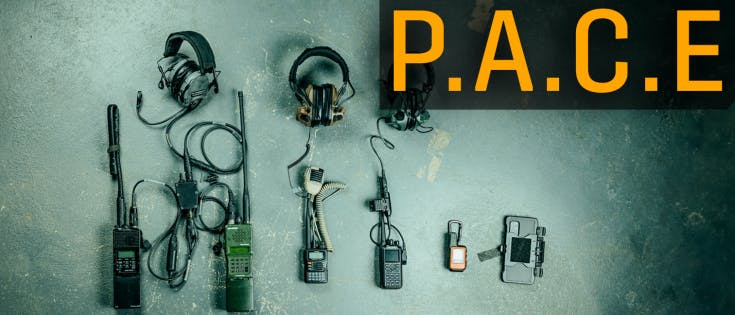If you have ever looked into any sort of tactical communications, you have probably run across the acronym PACE. It is used to establish communications precedence and stands for Primary, Alternate, Contingency, and Emergency. This sounds simple enough, but PACE planning can get complicated quickly. To be clear, PACE is a planning tool, and it does NOT determine what communication equipment you should own, but rather how and when to use your available communication methods.
This article is an introduction to PACE and how to implement it. Over the next few months, I will be going through the PACE planning process that is commonly used for tactical and emergency communications. Communications equipment can get complicated and technical, and so can figuring out what kind of equipment you should own and when to use it. Understanding this planning process will help you decide when and where to use your communication equipment and the capabilities required for a specific mission set.
Based on my experience, these are the 3 key points you should understand in order to create and implement a proper PACE plan:
1) PACE planning is phase specific and every mission will have multiple PACE plans.
2) You establish PACE plans for partner or other friendly forces to reach you and for team internal communications.
3) Determining what communication method is your Primary, Alternate, Contingency, and Emergency is based on a balance of 3 things:
– How secure the communication method is.
– How the communication method performs in your environment.
– How reliable and convenient the communication method is to use.
The information in this PACE article series will be based on various military communications manuals, but mostly on my personal experience as a MARSOC communicator. To facilitate better understanding of this planning tool, we will use a real-life operation I conducted overseas as an example case in the coming articles. As we walk through it, I will dive into each of the three key points outlined above and explain what it looks like to do PACE communication planning.
Operation Scenario:
Marine Special Operations Team (MSOT) 82XX will insert using a Ground Assault Force (GAF) via a Local National partner force to known Observation Point (OP) at grid 18S-TD-XXXXX-XXXXX to conduct defensive operations on the Forward Line of Troops (FLOT) via organic 120mm and 81mm mortars supported by organic small Unmanned Aerial Systems (sUAS) and organic Line of Sight (LOS) surveillance personnel for 96 hours. MSOT 82XX will have fixed-wing air support during all troop movements and during periods of darkness. Trident 25XX will be MSOT 82XX’s Quick Reaction Force (QRF) for the duration of the mission. MSOT 82XX is expected to relay significant information to the Marine Special Operations Company (MSOC) real-time and maintain communication windows every 4 hours.
In the next article, we will apply the first key point to the operation described. If you have any questions or comments about PACE planning, send them over to us at team@trex-arms.com.

